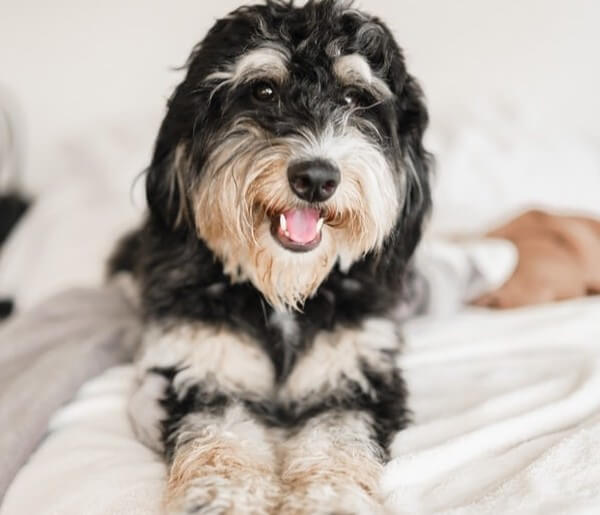
Bernedoodles are smart, loyal, and fun-loving family pets that will bring you years of joy and happy memories. With such a friendly personality and a calm temperament, it’s no wonder Bernedoodles make incredible therapy dogs.
Similar to Goldendoodles, Aussiedoodles, and numerous other Poodle mixes, the Bernedoodles also comes in many different coat colors and pattern. One of the most outstanding coat patterns in Bernedoodles is Merle and today, we’ll specifically discuss everything you need to know about the Merle Bernedoodles.
In this guide, we’ll go over Merle Bernedoodle genetics, common Merle Bernedoodle patterns, and include where you can find Merle Bernedoodle breeders and Merle Bernedoodle puppies for sale. Let’s begin!
Table of Contents
What is a Bernedoodle?
Poodles are so beloved worldwide that they have produced their own line of mixed breed dogs. These Poodle mixes are called Doodles, and you can find Doodles in various combinations. One popular Doodle is the Bernedoodle.
Bernedoodles are a result of mixing a Poodle with a Bernese Mountain Dog. Let’s check the chart below to understand how these pups came to be.
Now that we know where Bernedoodles come from, let’s learn what they look like.
Bernedoodle’s coat color and texture
The Bernedoodle coat can have a slightly wavy texture to tight curls, which only adds to their good looks. Canine enthusiasts and pet lovers admire their soft and dense coats for being non-shedding and hypoallergenic.
Bernedoodles come in various colors and patterns. From solids to bi-color and tri-colored coats, this pooch offers you lots of options. Bernedoodles often come in white, chocolate, red, tan, grey, black, and brown coats. One of their gorgeous coat colors is Merle. Let’s read a bit more about this beautiful pooch.
What is a Merle Bernedoodle?

Contrary to what many people believe, Merle is a pattern and not a coat color. Merle consists of up to three colors randomly distributed over the entire coat, giving the appearance of speckled or dappled markings.
The Bernedoodle Merle pattern can have varying degrees of darkness visible in the coat from light to heavy depending on its genotype and the other coloring factors it inherits. The colors you can find on a Merle coat include red, tan, grey, blue, chocolate, white, and black.
Merle Bernedoodle genetics

Merle coats result from the Merle gene. The Merle gene is semi-dominant, and you only need one copy of it to reproduce the color in future generations.
In other words, you need a Merle Poodle or a Merle Bernese Mountain Dog to get a Merle Bernedoodle.
Merle isn’t naturally present in Poodles or Bernese Mountain Dogs, which puts the purity of the parent breeds in question. However, various breeders claim that the Merle gene is a mutation and can occur naturally in a Poodle or a Bernese Mountain Dog without crossbreeding.
When both parents carry the Merle gene, the resulting pup is a double Merle. Double Merles suffer from congenital deformities like partial or total blindness, deafness, missing eyes, or partially functional ears. For these reasons, reputable breeders never mate two Merle canines together.
You may like: Australian Bernedoodle – Complete Guide
Merle Bernedoodle physical appearance
Merle Bernedoodles come in various sizes and have an athletic physique; however, their fluffy coats make them look fuller and thicker than they are. They have a robust, well-defined head that is proportionate to their bodies. Their faces carry a kind expression, and their facial hair resembles a bushy mustache.
Like all mix breeds, the physical appearance of a Merle Bernedoodle can vary tremendously. Depending on which parent they take after, they can have a wavy, straight, or curly coat.
Merle Bernedoodle coat colors and types
The Bernese Mountain Dog has a thick double coat, whereas the Poodle has a single coat with long curls. When making a Merle Bernedoodle, breeders always try to recreate the tight Poodle curls to ensure they are allergy-friendly.
However, this isn’t an exact science, and you can get Merle Bernedoodles with curly, wavy, or straight hair.
Merle Bernedoodles can have several coat shades depending on the color of their parents. As we mentioned above, Merle is a pattern and not a color. There are several patterns common among Merle Bernedoodles. Let’s go over what they are next.
Common Merle Bernedoodle patterns
Merle Bernedoodles have white base coats with variably faded patches of another color. Following are some common Merle Bernedoodle color combinations.
Blue Merle Bernedoodle
Blue Merle is the most well-known Merle coat. The Merle gene affects the black fur in the pup’s coat and turns it bluish-grey. This blue-grey exists as patches of varying dilution all over the Merle Bernedoodle’s body.
Blue Merle Bernedoodles can also have blue eyes. Their paw pads, noses, eye rims, and lips are also blue instead of the usual black.
You may be interested in: Blue Poodle – Complete Guide
Merle tri color Bernedoodle
A tri-color Merle Bernedoodle usually has tan points along with white and blue. These tan points always occur at certain places on the Bernedoodle’s body — usually the eyebrows, chest, insides of legs, and cheeks.
Blue isn’t the only variant of Merle tricolor Bernedoodle; these pups also come in other shades. There’s also the red tri Merle Bernedoodle with chocolate instead of blue.
Merle phantom Bernedoodle
A Merle phantom Bernedoodle carries the Merle gene but doesn’t express it in his coat. In many cases, the only way to identify a Phantom Merle Bernedoodle is through genetic testing.
Partnering these Bernedoodles with a Merle canine will result in double Merle puppies, leading to them having severe congenital disabilities. Legitimate breeders always genetically test the parents before breeding them to ensure they don’t produce double Merles accidentally.
SEE ALSO: Phantom Poodle (Complete Guide)
Red Merle Bernedoodle
Red Merle Bernedoodles are another popular Merle variant. Similar to how the Merle gene turns black to blue Merle, this gene turns chocolate to red Merle. Red Merle Bernedoodles also have brown paw pads, eye rims, lips, and noses.
You may also like: Red Poodle – Complete Guide
Sable Merle Bernedoodle
Sable Merle Bernedoodles are Merle with diluted fawn patches, but they also have dark-tipped fur on top of the fawn patches.
Merle Bernedoodle size, height, and weight
The Bernese Mountain Dog is a large canine, whereas the Poodle comes in multiple sizes.
Similarly, the Merle Bernedoodle comes in three sizes. A Blue Merle Bernedoodle full-grown size ranges from 12 to 29 inches, and their weight is between 20 to 110 pounds.
The smallest is the Merle toy Bernedoodle, followed by the Blue Merle mini Bernedoodle, with the Merle standard Bernedoodle being the largest of the bunch.
Merle Bernedoodle adult size
| Size group | Toy Merle Bernedoodle | Mini Merle Bernedoodle | Standard Merle Bernedoodle |
| Height | 12-17 inches | 18-22 inches | 23-29 inches |
| Weight | 20-24 pounds | 15-40 pounds | 45-110 pounds |
Merle Bernedoodle temperament and personality
Merle Bernedoodles are lively and playful pups. They make loyal family pets and are especially good with children because of their gentle nature.
Merle Bernedoodles can be stubborn at times, but they’re eager to please and intelligent, making training them a little easier than usual. They also need socialization training from an early age, or they can develop behavioral issues and a skittish personality.
Merle Bernedoodles are full of energy and love to play, but they can be calm and quiet indoors as well. They like to cuddle and will happily curl up on your lap or under the covers.
Do Merle Bernedoodles make great family pets?
Yes, Merle Bernedoodles are excellent family fur buddies. They are gentle with small children and love playing with them. They are good around pets of all sizes; however, you should always monitor the interaction between canines with a noticeable size difference to prevent any unfortunate incidents.
Check out: F1B Bernedoodle (Complete Guide)
Merle Bernedoodle training
Merle Bernedoodles are intelligent and eager to please. With proper training, they can become very obedient dogs. You should start them on basic obedience as early as possible.
It is crucial not to use harsh methods and punishments during training; this will only ingrain fear in your fur babies. A far more effective philosophy and approach is to use words of encouragement and tasty reward treats.
Merle Bernedoodle exercise requirement
Merle Bernedoodles have laid-back temperaments. You’ll have to take them on long daily walks to keep them fit and healthy. They love playing with kids and other dogs, so ensure that you have trained them properly, so they behave themselves while walking around the neighborhood.
Merle Bernedoodle grooming and cleaning
Merle Bernedoodles have a dense, curly coat that requires daily brushing and regular cleaning. They shed very little, so owners will not need to worry about too much hair in the house.
However, you still have to brush them to keep loose fur and dander off their coat. These pups also need to bathe more often than regular canines. The best time to wash them is after every couple of weeks or when they get filthy.
RELATED: Best Dog Shampoos – Reviews and Comparison
In addition to the above practices, you’ll want to trim your Merle Bernedoodle’s nails once every two weeks. If your pooch hates the nail clippers because they are loud or had an unpleasant experience, try using dog nail grinders instead.
Dog nail grinders features a whisper-quiet motor and a precision drum bit grinder that are effective at trimming your dog’s nails. If your pup is sensitive to noise, we highly recommend going with dog nail grinder instead.
You’ll also need to brush their teeth at least three times a week.
Is Merle Bernedoodle hypoallergenic?
The hypoallergenic qualities of the Merle Poodle’s coat are the prime reason behind their popularity.
People with mild to moderate dog allergies are usually okay with this breed. These pups shed minimally and produce little-to-no dander. They’re also dry-mouthed, meaning they don’t drool or slobber everywhere.
Merle Bernedoodle food and diet
Merle Bernedoodles should eat only high-quality dog food. Their fluffy coats hide their actual physique, so it’s necessary to have a vet weigh them regularly and adjust their diet accordingly.
Storebought food is often chock-full of filler ingredients like corn, grain, soy, and wheat that provide little to no nutritional value to dogs.
The ideal diet for your Merle Bernedoodle would be high in protein and low in carbs and fats. It should also contain essential vitamins, prebiotics, minerals, and fatty acids.
Be careful when making drastic alterations to your four-legged friend’s diet. Most canines can’t handle sudden diet changes and can suffer gastrointestinal issues. Stick to a regular dietary routine and food choice. If you need to change your Merle Bernedoodle’s diet, always do it gradually and with your vet’s approval.
It’s best to feed them twice a day—once in the morning and again at night. Eating too much at once can result in bloat. Make sure that you leave fresh water out for your pup throughout the day if possible.
You may be interested in: How Many Times A Day Should A Puppy Poop?
Merle Bernedoodle common health issues
A Merle Bernedoodle is much healthier than either of his parents and likely won’t inherit any of the problems its parent breeds might have, making them a low-risk choice.
The only thing that can sometimes be a problem is the Merle gene itself. Here are some issues Merle Bernedoodle owners should be aware of.
1. Hypothyroidism
The puppy will have a dull coat, lethargy, and weight gain despite eating less. Hypothyroidism is when there is a lack of thyroxine hormone in the pup’s body.
2. Hip Dysplasia
Hip dysplasia is a condition that causes an abnormal hip socket formation, leading to chronic pain and arthritis, even muscle atrophy in severe cases. It tends to affect medium to large breeds more often than smaller ones.
3. Gastric Dilatation-Volvulus (GDV or bloat)
GDV affects large, deep-chested breeds like the Bernese Mountain Dog. It is a condition in which gas, fluid, or food swells the stomach, sometimes making it twist on its axis.
4. Congenital blindness and deafness
The Merle gene has a high association with genetic defects. Merle pups can be mild to severely deaf, blind, or both. The associated risks increase significantly if the puppy is a double Merle.
5. Color dilution alopecia
This condition affects Bernedoodles with the Merle gene. When melanin is low in certain areas on the coat, it causes loss of color and increases susceptibility to sun damage.
Merle Bernedoodle lifespan
On average, Merle Bernedoodles can live 12 to 18 years. The variation is considerable due to the genetic shortcomings of the Merle Bernedoodle.
Merle Bernedoodle price
A Merle Bernedoodle puppy can cost anywhere from $2,000 to over $5,000. Their price depends on the breeder and the pup’s size and lineage.
Another factor that influences their price is their coloring. Merle Bernedoodles with rarer coat colors usually cost more. There’s also more appeal for the mini and toy Merle Bernedoodles, and they generally cost higher than standard Merle Bernedoodles.
How is a Merle Bernedoodle produced?
A Bernedoodle is a product of partnering a Poodle with a Bernese Mountain Dog. To get one with the Merle coat, you only need one of the parents to carry the Merle gene. The breeder will usually try to select those dogs with the fewest health problems as parents to ensure that the pup has no significant health issues.
Merle Bernedoodle breeder
A breeder with knowledge about the breeds they are selling will provide all available pedigree information for both parents, as well as their veterinarian records. They will also answer any questions you may have about the pups.
A reputable breeder — such as the Merle Bernedoodle Canada breeder Swiss Ridge Kennels — provides their breeding dogs’ health certificates conducted by recognized veterinary labs. They should also have the parents’ test results for common health problems like hip dysplasia.
Merle Bernedoodle puppies
Blue Merle Bernedoodle puppies should be playful and curious but not overly hyper. They should have a soft coat with no bare patches, and the skin around the eyes should not be red or crusty. The pup’s stool should also not contain mucus or blood.
When bringing a Merle Bernedoodle home for the first time, make sure to bring your other pets to meet them. Introduce all of your animals slowly and monitor their interactions closely to ensure that they are safe together.
Merle Bernedoodle for sale
Blue Merle Bernedoodle for sale
You can find some lovely blue Merle Bernedoodles for sale at Designer Bernedoodles.
Blue merle mini Bernedoodle for sale
Mini Merle Bernedoodles are a smaller version of the standard Merle Bernedoodle and look adorable. You can buy some at Rocky Mtn Bernedoodles.
Blue Merle Toy Bernedoodle for sale
If you’d prefer your Merle Bernedoodle even smaller, go for a lovable toy Merle Bernedoodle. Check out Utah Bernedoodle for the most adorable toy Merle Bernedoodles.
Merle Bernedoodle puppies for sale
Bernedoodles are a beloved breed and among the most popular Doodles out there. You can find numerous online responsible breeders that have toy, standard, and Merle mini Bernedoodle puppies for sale.
No matter which breeder you select, make sure to check their medical paperwork thoroughly and read their reviews before purchasing from them.
Is the Merle Bernedoodle right for me?
The Merle Bernedoodle is a wonderful family pet, thanks to his amazing temperament, winning personality, and hypoallergenic coat.
However, he will need training during puppyhood and lots of love from his owners. He can be friendly with strangers but takes some time to warm up to them before letting his guard down.
Merle Bernedoodles come in three sizes to fit a house of any size. These pups are also adaptable, meaning they take little time to adjust to new environments. Overall, the Merle Bernedoodle is a healthy, loving, and loyal family pet.
DISCLAIMER: THIS WEBSITE DOES NOT PROVIDE MEDICAL ADVICE
The information, including but not limited to, text, graphics, images and other material contained on this website are for informational purposes only. No material on this site is intended to be a substitute for professional veterinary advice, diagnosis, or treatment. Always seek the advice of your veterinarian or other qualified health care provider with any questions you may have regarding a medical condition.
Resources:
https://en.wikipedia.org/wiki/Merle_(dog_coat)
https://pubmed.ncbi.nlm.nih.gov/7440313/

With over five years of specialized experience as an animal writer, my expertise lies in dog nutrition, health, behavior, grooming, and training. I am dedicated to delivering helpful and informative content that caters to the well-being of our furry friends. My primary goal is to empower pet owners with knowledge and ensure our canine companions thrive in health and happiness. In my free time, I love volunteering at local dog rescue centers.







